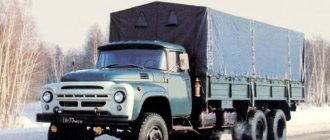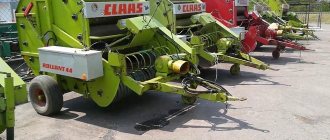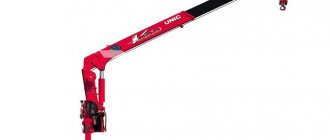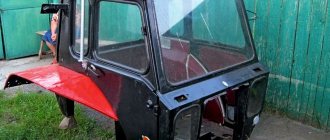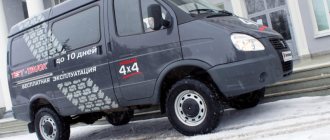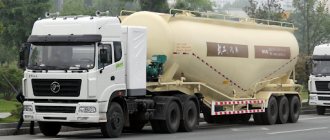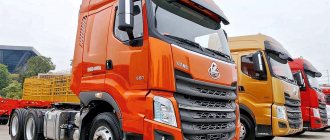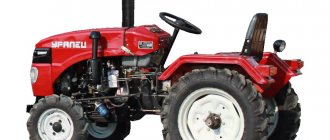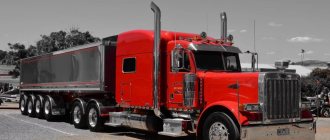[albert25051994]
06.06.2016,
Everyone has seen an American hooded tractor at least once in their life. And how, exactly, can one not notice it? Nosy, swift, big - all these epithets, of course, are about Americans. At the beginning of the 2000s, Americans with hoods poured into Russia in a flood, leaving all KamAZ and MAZ trucks at the end of the line. But what's the matter? Why did our truckers switch to overseas trucks? Since American tractors are direct competitors to Europeans, let's figure out which side is stronger.
Huge cabin
She's really huge. This is the most important and important advantage related to American bonnets. No competitor has a cabin like the American one. Our drivers, of course, appreciated the possibility of capacity and transformation of the cabin. You can live in an American tractor! Everything you need is here:
- Microwave
- TV
- Coffee maker
- Water dispenser
- Two huge beds
In addition, in the Freightliner Cascadia you can easily stand up to your full height, the floor is flat, and there are a huge number of drawers and shelves.
After all, this is all you need for a calm, fulfilling life! Drivers of the Freightliner Cascadia, and other similar tractors, do not think about where to find a decent place to park and rest. You can spend the night in the car, wash your face, eat normal food, watch TV during breakfast, and drink fresh coffee. The bed is really big and you can sleep in any position, and a large number of drawers allows you to take any number of things with you. Some American tractors even have a shower! If we are to compare with Europeans, then let’s compare the cabins of the Freightliner Cascadia and say the same Scania. All that the European can offer is two meager sleeping places.
Powerful engine
The engine is really powerful and you can’t argue with that either.
The Freightliner Cascadia, for example, has a regular engine output of 560 horsepower. Agree, impressive. Especially compared to its European classmates, whose standard engines produce 380-440 horsepower. Reliability is added to the powerful engine. American trucks are designed to operate with a trailer with a gross weight of up to 60 tons, which is why they need such a powerful engine. In Russia, the permitted weight is almost a third less, which means that the tractor does not strain. The engine, even if desired, cannot be loaded more than 2/3, exactly, like the suspension, gearbox, etc. This is probably why Freightliner Cascadia tractors run on average up to 2.5-3 million kilometers before major repairs. If you can’t imagine what a huge figure this is, then just think about the fact that our domestic KamAZ-5490, according to the plant (!), will be able to travel up to a million kilometers without major repairs. And the Freightliner Cascadia runs three times longer even without factory announcements.
Russian America. Review of American Trucks
I don’t have exact statistics, but based on visual observations, I think I can say that the largest fleet of American trucks outside the North American continent is concentrated in Russia.
Only Canada and Mexico and, naturally, the United States itself can boast of a larger number of American bonnets than in Russia. Such machines are found in large numbers in all regions of the Russian Federation, starting from the Smolensk region and ending with Petropavlovsk-Kamchatsky. Which brands and models predominate? I’ll try to create some kind of conditional “popularity rating” based on my own experience of traveling across Russian expanses.
Freightliner, or “Fred,” is the clear winner. Freightliner is also the leader in sales in America. And Freightliner Century Class is the most popular “Fred” in Russia. The Century Class has been the brand's flagship since the mid-1990s. Accordingly, at the time when economic growth began in the Russian Federation, the most popular “used” tractor in the United States was the Century Class model. They began to import it in batches to Russia. That is why there are most of them in the Russian Federation.
The Century Class was replaced by the Freightliner Columbia. When the US secondary market began to fill with these cars, they immediately began to be transported to Russia.
And this is the Freightliner FLD120 Classic XL - true Western style! In America itself, “Western classics” are bought mainly by private owners, and not by large transport companies (the main suppliers of used cars to the market). Such cars are not widespread even in the USA, private owners rarely sell them, these cars are more expensive than “pop”. That is why in Russia there are few “classics” in the Western style. But true fans have it.
I can’t help but show you a unique phenomenon that can only occasionally be observed in central Siberia. An American tractor (the Columbia we already know) coupled with a long Chinese semi-trailer-car carrier. The length of the “cart” is 19 meters! The main “habitat” of such trains is Transbaikalia, the Irkutsk region and rarely the Krasnoyarsk Territory.
But let's return to market positions. The overseas division of Volvo has seriously squeezed out native American brands in the US market, but is not among the top three sales leaders in the United States. However, in Russia, the Volvo VNL model has a clear “silver” in terms of popularity after Freightliner products.
I specially selected another frame of a Volvo VNL in the same white color. Notice anything unusual? Look at the headlights.
Do you recognize the optics from the VAZ Priora? Large Volvo VNL headlights often break. Ordering new ones from the USA is time-consuming and expensive. But Russian ingenuity saves the situation. Several “cooperatives” immediately launched the production of plastic frames, into which by inserting headlights from Russian cars, you can get a new light for American trucks. Priora and Kalina are the main donors.
What about the products of the most famous US truck companies? They are being taken to Russia too. Kenworth is the Cadillac of the heavy-duty truck world. The photo shows a fairly recent Kenwort T660, photographed in Irkutsk. He is pulling a Polish Wielton semi-trailer behind him. This combination cannot be seen either in the USA or in Poland. This is only possible in Russia.
If Kenworth is compared to Cadillac, then Peterbilt is the Lincoln of the trucking world. Kenworth and Peterbilt were eternal rivals until they became part of the same PACCAR corporation. The picture shows a Peterbilt 387. Like the Kenworth T660 from the previous picture, this truck is also a representative of the cohort of “aerodynamic” tractors, designed for the needs of large transport companies, and not conservative private owners. Service of a tractor in a large transport company in the USA greatly increases the likelihood of a truck changing its citizenship to Russian.
"Aerodynamic" tractors, which violated the canons of the "Western" style, were brought to life by rising fuel prices. Large transport companies wanted to cut costs, manufacturing companies were forced to change the style of long-haul tractors. This is how International came up with the ProStar model, made according to the canons of biodesign. As soon as the first ProStars appeared on the American secondary market, they immediately began to “flow” to Russia.
To be fair, it should be said that International’s position in American “long-range combat” is not very strong. The American is more accustomed to “Inter” in the role of a “regional” or a medium-tonnage truck. Here in this segment International is great. Therefore, it is not surprising that if there is an American “regional” on Russian roads, then most likely it will be International.
And if you meet an American urban medium-duty truck on Russian roads, then most likely it will also be an International. This specimen was photographed in the Vladimir region.
But American dump trucks are very rare in the Russian Federation. They have not gained popularity in the vast Russian construction equipment market. Individual specimens, of course, appear in Russia, but they don’t make the weather there. Therefore, this four-axle Kenworth coal tanker, which somehow ended up in Kemerovo, is unique from all points of view.
What is the reason for the success of the American long-haul second-hand store in Russia? Here a complex of factors has formed into a successful chain. The first reason is legislative - the official permissible length of a road train in Russia allows long American tractors to work in pairs with European semi-trailers. The second reason is economic - a very, very attractive price. The third reason is anatomical - the size of sleeping bags is legendary. But these are not legends, but the truth. “When I go to bed, I forgive everything,” truck drivers say.
What do I “forgive”? In terms of technical excellence, American trucks are noticeably inferior to European ones; many even have an unsynchronized gearbox. But for spacious sleeping bags, many drivers are ready to turn a blind eye even to an unsynchronized gearbox.
In used vehicles, the position of American tractors in Russia is incredibly strong. There were years when the import of “used” “Americans” exceeded the import of “used” “Europeans”.
So why aren’t new American trucks being brought to Russia? Here a complex of factors has formed an unfortunate chain. New cars cost very different money. In addition, the appearance of new American trucks in the Russian Federation is greatly hampered by European concerns. How do they do this? Elementary! Almost all American freight lines are owned by Europeans! Hence the possibility of influence.
MAZ could easily get into the market segment of bonneted long-range tractors! But, of course, not with the help of the first experimental bonnet, in which a nose was “attached” to the standard cabin.
But the hood of the “2012 model”, which has a full-size spacious sleeping compartment, could well become an excellent alternative to the American used car. It is a pity that work on this topic is virtually frozen.
For Europe, of course, such cars would not be suitable, but the domestic Russian market would, I’m sure, accept them with a bang. Dear Mazovians! Don’t rush to “bury” the hood issue!
Dmitry GLADKY Photo by ABW.BY
Two meters of life ahead
Of course, an accident is an unpleasant moment, but you need to consider its possibility.
In the event of a frontal impact, the driver of an American tractor is protected by the engine, unlike the driver of a European tractor, whose engine is located under him. Taken together, the driver of a Freightliner Cascadia is protected by the engine, front end lining, front axle, and strength elements of the body, while the driver of a European truck is protected only by the lining. Minuses
The only downside that can be noted is that such a tractor can only be driven within the Russian Federation. Abroad, such tractors do not travel along the length.
Difference from European
Truck tractors from Europe and America differ greatly from each other in many respects:
- the large hood of the “American” and the flat vertical front of the “European”;
- drum brakes on American models and mostly disc brakes on European ones;
- the number of bridges for “Americans” and “Europeans” is 2 and 3, respectively;
- American models do not have underrun devices on trailers, which European and Russian heavy trucks are always equipped with;
- American trucks have a voltage of 12 V, while European trucks have 24 V.
Another characteristic feature of the “Americans” is that these tractors are medium and heavy at the same time. And the classification depends only on the engine power and the type of gearbox.
BY THE WAY! On the Internet you can find many comparisons of European and American type trucks, equipped with photos, as well as different ones on them.
Comparison
The comparison price will be approximately 4 million rubles.
This is quite a bit for a thoroughbred tractor. But what competitors? KamAZ-5490 is a new domestically produced truck. Although, of course, this is a Mercedes-Benz Actros in an old body, but now the converted Mercedes is produced under the KamAZ brand. Nobody knows how many kilometers he will walk, and whether they will be so carefree. Scania – for 4 million rubles you can buy a three-year-old tractor in decent condition. It will be better than the new KamAZ, but worse than a bonneted American tractor. If you now ask why Scania is worse than Freightliner Cascadia, then scroll up a little - all the arguments are described there.
Freightliner Cascadia is the one that deserves more attention. Think for yourself, for 4 million rubles you can buy a two or three year old Freightliner Cascadia with a mileage of only 200-300 thousand kilometers. This will be a top tier truck. All the arguments described above speak in its favor. In addition, it will have an advantage that the new KamAZ will not have - American quality. You can, of course, argue for a long time about the quality of the Americans, but no one will argue that it is many times better than the Russian build quality.
Thus, the choice, of course, falls on the American Freightliner Cascadia tractor. All its advantages are described above, and they really matter.
